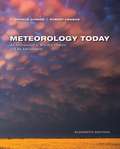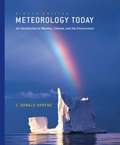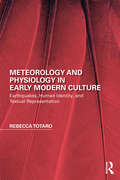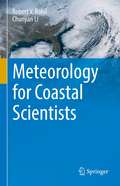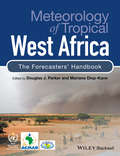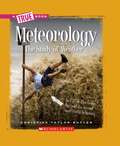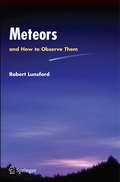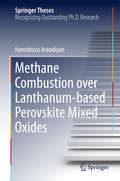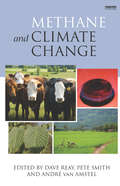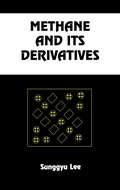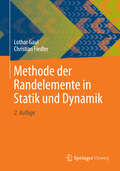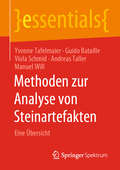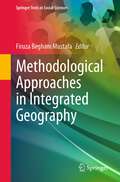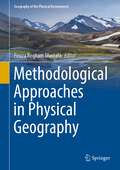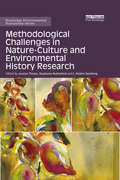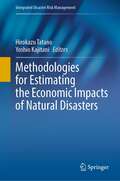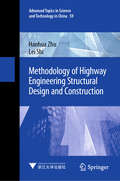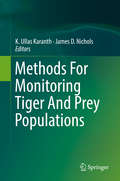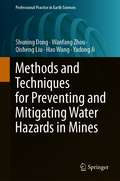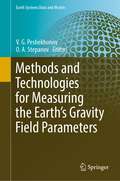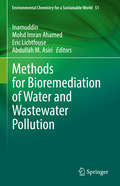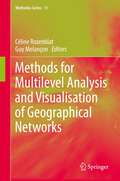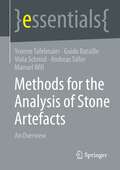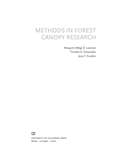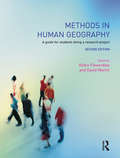- Table View
- List View
Meteorology Today: An Introduction to Weather, Climate, and the Environment
by Robert Henson C. Donald AhrensNIMAC-sourced textbook <P><P>C. Donald Ahrens and Robert Henson combine expert content in weather, climate, and earth science with the interactive experience you expect from Cengage Learning. Grounded in the scientific method, this reader-friendly and highly visual book shows you how to observe, calculate, and synthesize information as a budding scientist, systematically analyzing meteorological concepts and issues. Specific discussions center on severe weather systems, such as tornadoes, thunderstorms, and hurricanes, as well as everyday elements, such as wind, precipitation, condensation, masses and fronts, and the seasons. Events and issues dominating today's news cycles also receive thorough attention, and include analysis of Superstorm Sandy, the Oklahoma tornadoes, recent findings from the US National Climate Assessment and the Intergovernmental Panel on Climate Change, and more. Whether you choose a bound book or eBook, METEOROLOGY TODAY, 11th Edition is a dynamic learning experience packed with end-of-chapter summaries, key terms, review questions, exercises and problems, live animations, web links, and more to carry your learning to atmospheric heights!
Meteorology Today: An Introduction to Weather, Climate, and the Environment, 8th Ed.
by C. Donald AhrensIllustrated throughout with color photographs, satellite images, and diagrams, this textbook gives undergraduates a visual introduction to the study of meteorology. The emphasis is on the understanding and application of meteorological principles, and students are encouraged to apply what they have learned when observing the weather around them. The 19 self-contained chapters can be covered in any order desired. A removable, laminated cloud chart poster is found at the back of the volume. Annotation ©2006 Book News, Inc. , Portland, OR (booknews. com)
Meteorology and Physiology in Early Modern Culture: Earthquakes, Human Identity, and Textual Representation (Perspectives On The Non-human In Literature And Culture Ser.)
by Rebecca TotaroMeteorology and Physiology in Early Modern Culture: Earthquakes, Human Identity, and Textual Representation provides the first sustained examination of the foundational set of early modern beliefs linking meteorology and physiology. This was a relationship so intimate and, to us, poetic that we have spent centuries assuming early moderns were using figurative language when they represented the matter and motions of their bodies in meteorological terms and weather events in physiological ones. Early moderns believed they inhabited a geocentric universe in which the matter and motions constituting all sublunary things were the same and that therefore all things were compositionally and interactively related. What physically generated anger, erotic desire, and plague also generated thunder, the earthquake, and the comet. As a result, the interpretation of meteorological events, such as the 1580 earthquake in the Dover Strait, was consequential. With its radical and seemingly spontaneous shaking, an earthquake could expose inconvenient truths about the cause of matter and motion and about what, if anything, distinguishes humans from every other thing and from events. Meteorology and Physiology in Early Modern Culture reveals a need for reexamination of all representations of meteorology and physiology in the period. This reexamination begins here with a focus on the Titanic metamorphoses captured by Edmund Spenser, William Shakespeare, John Donne, and the many writers responding to the 1580 earthquake.
Meteorology for Coastal Scientists
by Robert V. Rohli Chunyan LiThis is a textbook for non-atmospheric specialists who work in the coastal zone. Its purpose will be to help coastal environmental, engineering, and planning professionals to understand coastal atmospheric processes. This in turn will allow more effective communication with climate modelers, atmospheric environmental consultants, and members of the media.The coastal environment is among the most intensively used and chronically abused components of the Earth-ocean-atmosphere system. It is also home to an ever-increasing proportion of humanity with their increasing development, trade, transportation, and industrial activities, amid increasing impacts of natural hazards. The atmosphere is an integral part of the system, with all of the above human activities affecting and being affected by atmospheric processes and hazards. Yet few of the specialists studying the coastal environment have expertise on atmospheric processes, this therefore presents a highly relevant textbook on coastal atmospheric processes.
Meteorology of Tropical West Africa: The Forecasters' Handbook
by Douglas J. Parker Mariane Diop KaneMeteorology of tropical West Africa: the Forecasters’ Handbook presents the science and practice of weather forecasting for an important region of the tropics. Connecting basic theory with forecasting practice, the book provides a unique training volume for operational weather forecasters, and is also suitable for students of tropical meteorology. The West African region contains a number of archetypal climatic zones, meaning that the science of its weather and climate applies to many other tropical regions. West Africa also exhibits some of the world’s most remarkable weather systems, making it an inspiring region for students to investigate. The weather of West Africa affects human livelihoods on a daily basis, and can contribute to hardship, poverty and mortality. Therefore, the ability to understand and predict the weather has the potential to deliver significant benefits to both society and economies. The book includes comprehensive background material alongside documentation of weather forecasting methods. Many examples taken from observations of West African weather systems are included and online case-studies are referenced widely.
Meteorology: The Study Of Weather (New True Books: Space)
by Christine Taylor-ButlerA True Book: Earth Science series presents fascinating facts and fun activities that will engage the budding earth scientist, while exploring the fields of geology, meteorology, ecology, and more. This series includes an age appropriate (grades 3-5) introduction to curriculum-relevant subjects and a robust resource section that encourages independent study. Readers will find out how meteorologists study patterns in Earth's atmosphere to predict temperature changes, dangerous storms, and even global climate change.
Meteors and How to Observe Them
by Robert LunsfordThe focus of this book is to introduce the novice to the art of meteor observing. It explains in straightforward language how best to view meteor activity under a variety of conditions, regardless of the observer's location. The observing conditions for each meteor shower are vastly different from each of the Earth's regions and this book would be valuable to any potential observer from Australia to Alaska. The calendar chapters list activity as it occurs throughout the year. The list is limited to showers that the amateur observer can actually see (some sources list radiants that are impossible to observe without photographic or video methods). Not only are the annual showers discussed, but the random sporadic meteor activity is also included for each region. This is important, as there are many more nights throughout the year when the sporadic background will provide more activity than that provided by the annual showers!
Methane Combustion over Lanthanum-based Perovskite Mixed Oxides
by Hamidreza ArandiyanThis book presents current research into the catalytic combustion of methane using perovskite-type oxides (ABO3). Catalytic combustion has been developed as a method of promoting efficient combustion with minimum pollutant formation as compared to conventional catalytic combustion. Recent theoretical and experimental studies have recommended that noble metals supported on (ABO3) with well-ordered porous networks show promising redox properties. Three-dimensionally ordered macroporous (3DOM) materials with interpenetrated and regular mesoporous systems have recently triggered enormous research activity due to their high surface areas, large pore volumes, uniform pore sizes, low cost, environmental benignity, and good chemical stability. These are all highly relevant in terms of the utilization of natural gas in light of recent catalytic innovations and technological advances. The book is of interest to all researchers active in utilization of natural gas with novel catalysts. The research covered comes from the most important industries and research centers in the field. The book serves not only as a text for researcher into catalytic combustion of methane, 3DOM perovskite mixed oxide, but also explores the field of green technologies by experts in academia and industry. This book will appeal to those interested in research on the environmental impact of combustion, materials and catalysis.
Methane and Climate Change
by Pete Smith David Reay Andre Van AmstelMethane is a powerful greenhouse gas and is estimated to be responsible for approximately one-fifth of man-made global warming. Per kilogram, it is 25 times more powerful than carbon dioxide over a 100-year time horizon -- and global warming is likely to enhance methane release from a number of sources. Current natural and man-made sources include many where methane-producing micro-organisms can thrive in anaerobic conditions, particularly ruminant livestock, rice cultivation, landfill, wastewater, wetlands and marine sediments. This timely and authoritative book provides the only comprehensive and balanced overview of our current knowledge of sources of methane and how these might be controlled to limit future climate change. It describes how methane is derived from the anaerobic metabolism of micro-organisms, whether in wetlands or rice fields, manure, landfill or wastewater, or the digestive systems of cattle and other ruminant animals. It highlights how sources of methane might themselves be affected by climate change. It is shown how numerous point sources of methane have the potential to be more easily addressed than sources of carbon dioxide and therefore contribute significantly to climate change mitigation in the 21st century.
Methane and its Derivatives (Chemical Industries Ser. #70)
by Sunggyu Lee"Covers the chemistry, process chemistry, technology, engineering, and economics of methane conversion, including its environmental impact and commercial exploitation. Begins with methane's availability and increasing importance as an environmentally acceptable natural resource alternative and feedstock."
Methode der Randelemente in Statik und Dynamik
by Lothar Gaul Christian FiedlerDie gut eingeführte Methode der Randelemente baut auf den Grundlagen der Kontinuumsmechnik auf. In diesem Buch wird sie für die Elastodynamik schwingender Strukturen und für die Elastostatik formuliert. Die mathematischen und ingenieurwissenschaftlichen Grundlagen werden bereitgestellt; einfache Beispiele erleichtern das Verständnis. Das Buch liegt nun in einer 2. korrigierten Auflage vor. Es richtet sich an Studierende, Ingenieure und Naturwissenschaftler, die sich Kenntnisse der Randelementmethode erarbeiten wollen.
Methoden zur Analyse von Steinartefakten: Eine Übersicht (essentials)
by Yvonne Tafelmaier Guido Bataille Viola Schmid Andreas Taller Manuel WillDieses essential gibt einen Überblick über aktuelle Analysemethoden von Gesteinsartefakten von der Attributanalyse ganzer Inventare bis hin zu mikroskopischen Gebrauchsspurenanalysen einzelner Artefakte. Dabei zeigen die vorgestellten Ansätze die Bandbreite der Analyse urgeschichtlicher Steinartefakte im deutschsprachigen Raum. Einfache Anwendungsbeispiele veranschaulichen die Möglichkeiten und Einschränkungen der jeweiligen Methode. Der Inhalt und die Struktur des essentials ist identisch mit Unterrichtseinheiten zur Erlernung von Methoden der Steinartefaktanalyse an der Universität Tübingen im Fachbereich Ältere Urgeschichte.
Methodological Approaches in Integrated Geography (Springer Texts in Social Sciences)
by Firuza Begham MustafaThis book covers methodology of the study for all aspects of human geography. As a comprehensive geography textbook, it consists of detailed research methodology for research in human geography including a few selected case studies in Asia. It explores different approaches, methodological possibilities, and challenges in conducting geographical research in human geography. New digital geographic data sources and GIS applications can help researchers to receive clearer concepts and obtain better measurements of the relevant attributes changes. Furthermore, the book provides an opportunity to critically examine the conceptualization and identification of the field in geographical research and how digital media has not only expanded the scope of what constitutes the field but has redefined the field in itself as well as the practices of observing, knowing, and analyzing the real world. The uniqueness of this book is due to the contribution of several professors and subject experts from South East and East Asia with special particular reference to cases studies from this region of the world.
Methodological Approaches in Physical Geography (Geography of the Physical Environment)
by Firuza Begham MustafaGeography science aims to observe the dynamics in describing earth's surface as a place and space for humans to carry out their lives, starting from simple identification using recording and sketching models, then utilizing tools such as maps, satellite imagery, statistics and Geographic Information Systems (GIS). In the development of geography science, it is appropriate to explain phenomena of the earth in the present context along with the process of developing science and technology using suitable and effective methods. Physical geography is the branch of natural science that deals with the study of processes and patterns in the natural environment such as the atmosphere, hydrosphere, lithosphere and biosphere. This book covers the methodology of the study for all aspects of physical geography, biosphere, hydrosphere, lithosphere, and atmosphere. A comprehensive geography textbook consists of a detailed research methodology for physical geography research including a few selected case studies in Asia. The uniqueness of this book is due to the contribution of several professors and subject experts from South East and East Asia with special particular reference to cases studies from a particular region. This book covered selected methodological approaches for hydrology, climatology and geomorphology including the discovery of the best method for exploring and assessing mysterious physical phenomena using a diversity of methodologies. This book explains the principal concept, basic method, optional method, detailed description of each method, and the advantages and disadvantages of the various methods. The technique of data selection, data acquisition, method of analysis, data interpretation and data analysis techniques with a specific focus on deterministic modeling, geography techniques, geospatial modeling with Geographic Information System (GIS), Artificial Intelligence (AI), Analytic Hierarchy Process (AHP), and Automated machine techniques and combination of statistical analysis. This book attempts to explore different approaches, methodological possibilities and challenges in conducting geographical research in physical geography. New digital geographic data sources and GIS applications can help researchers to receive clearer concepts and obtain better measurements of the relevant attributes changes in the physical environment. Opportunity to critically examine the conceptualization and identification of the field in geographical research and how digital media has not only expanded the scope of what constitutes the field but has redefined the field in itself as well as the practices of observing, knowing, and analyzing the real world.
Methodological Challenges in Nature-Culture and Environmental History Research (Routledge Environmental Humanities)
by L. Anders Sandberg Jocelyn Thorpe Stephanie RutherfordThis book examines the challenges and possibilities of conducting cultural environmental history research today. Disciplinary commitments certainly influence the questions scholars ask and the ways they seek out answers, but some methodological challenges go beyond the boundaries of any one discipline. The book examines: how to account for the fact that humans are not the only actors in history yet dominate archival records; how to attend to the non-visual senses when traditional sources offer only a two-dimensional, non-sensory version of the past; how to decolonize research in and beyond the archives; and how effectively to use sources and means of communication made available in the digital age. This book will be a valuable resource for those interested in environmental history and politics, sustainable development and historical geography.
Methodologies for Estimating the Economic Impacts of Natural Disasters (Integrated Disaster Risk Management)
by Hirokazu Tatano Yoshio KajitaniThis book outlines methodologies to estimate the economic impacts of natural disasters based on business surveys conducted after large disasters in Japan. By including numerous observations on business activities in past disasters and the validations of both engineering and economic models based on these data sets, this book appeals to practitioners who estimate the regional economic impacts as well as to students and young professionals in various fields who conduct disaster impact studies. The book consists of 7 chapters and includes theories and practices, which help readers to interlink the estimation methods with real-world problems. The study primarily focuses on cases in Japan, but the methods employed can be generalized and applied in other countries.
Methodology of Highway Engineering Structural Design and Construction (Advanced Topics in Science and Technology in China #59)
by Hanhua Zhu Lei ShiThis book mainly studies the methodologies of structural design and construction for highway engineering, which are applicable to the overall control and the precise operation of engineering structures. It explores the method of comprehensive analysis, the simplification of complex problems, and the application of typical engineering tools. In turn, the book presents a number of innovative approaches, e.g. the coordinated control of structural deformation method, the theory of underground engineering balance and stability, and the soft soil foundation treatment of “bumping at the bridgehead.” These methodologies are then illustrated in typical cases and representative problems, explained from a practical standpoint. Examples in special settings are also discussed, e.g. highway construction in Tibet, and rebuilding after the Wenchuan earthquake. The book offers a valuable reference guide for all those whose work involves highway engineering design, construction, management, and scientific research.
Methods For Monitoring Tiger And Prey Populations
by K. Ullas Karanth James D. NicholsThis book addresses issues of monitoring populations of tigers, ungulate prey species and habitat occupancy, with relevance to similar assessments of large mammal species and general biodiversity. It covers issues of rigorous sampling, modeling, estimation and adaptive management of animal populations using cutting-edge tools, such as camera-traps, genetic identification and Geographic Information Systems (GIS), applied under the modern statistical approach of Bayesian and likelihood-based inference. Of special focus here are animal survey data derived for use under spatial capture-recapture, occupancy, distance sampling, mixture-modeling and connectivity analysees. Because tigers are an icons of global conservation, in last five decades,enormous amounts of commitment and resources have been invested by tiger range countries and the conservation community for saving wild tigers. However, status of the big cat remains precarious. Rigorous monitoring of surviving wild tiger populations continues to be essential for both understanding and recovering wild tigers. However, many tiger monitoring programs lack the necessary rigor to generate the reliable results. While the deployment of technologies, analyses, computing power and human-resource investments in tiger monitoring have greatly progressed in the last couple of decades, a full comprehension of their correct deployment has not kept pace in practice. In this volume, Dr. Ullas Karanth and Dr. James Nichols, world leaders in tiger biology and quantitative ecology, respectively, address this key challenge. The have collaborated with an extraordinary array of 30 scientists with expertise in a range of necessary disciplines - biology and ecology of tigers, prey and habitats; advanced statistical theory and practice; computation and programming; practical field-sampling methods that employ technologies as varied as camera traps, genetic analyses and geographic information systems. The book is a 'tour de force' of cutting-edge methodologies for assessing not just tigers but also other predators and their prey. The 14 chapters here are lucidly presented in a coherent sequence to provide tiger-specific answers to fundamental questions in animal population assessment: why monitor, what to monitor and how to monitor. While highlighting robust methods, the authors also clearly point out those that are in use, but unreliable. The managerial dimension of tiger conservation described here, the task of matching monitoring objectives with skills and resources to integrate tiger conservation under an adaptive framework, also renders this volume useful to wildlife scientists as well as conservationists.
Methods and Techniques for Preventing and Mitigating Water Hazards in Mines (Professional Practice in Earth Sciences)
by Hao Wang Shuning Dong Wanfang Zhou Qisheng Liu Yadong JiThis book summarizes the advances in mine hydrogeology in terms of the development of new technologies and sustainable mining to prevent water inrush disasters during coal-mine construction and production in China. It presents holistic topics that balance safe coal mining and the minimization of impacts on the environment and human beings. Systematically describing the methods and techniques used in China’s coal mines to predict, prevent and mitigate water inrushes, it includes nine case studies to illustrate the practical engineering solutions using state-of-art methods and technologies under various conditions. It also discusses how the approaches could help solve the world’s water problems, not only in mining, but also in tunneling, disposing of nuclear waste, storing natural gas, and sequestering CO2, as well as their impact on mining industries and related fields around the world. The book intended for students, researchers and practitioners working in the mining industries.
Methods and Technologies for Measuring the Earth’s Gravity Field Parameters (Earth Systems Data and Models #5)
by V. G. Peshekhonov O. A. StepanovThis book offers extensive information on the operation of gravimeters, including airborne, marine and terrestrial ones, and on the associated data processing methods such as optimal and adaptive filtering, smoothing, structural and parametric identification. Further, it describes specific features relating to the study of the gravitational field in remote areas of the Earth, with the necessary modifications of equipment and software for all-latitude applications. Findings from gravity studies in such remote areas are also presented. Advanced methods for studying the gravitational field, including those for simultaneous determination of gravity anomalies and deflection of the vertical are described and analyzed in detail. Gravity gradiometers and cold atom gravimeters are also covered. Last but not least, the book deals with the development of Earth’s gravity field models and their various applications, including map-aided navigation, with a special attention to model accuracy estimation. Gathering research findings and best practice recommendations relating to Earth’s gravity field measurements, collected by a team of researchers and professionals, the book offers a unique guide for engineers, scientists and graduate students dealing with terrestrial, marine and airborne gravimetry. It will also help other specialists involved in developing and using navigation systems in practice, including designers of gravimetric equipment and navigators.
Methods for Bioremediation of Water and Wastewater Pollution (Environmental Chemistry for a Sustainable World #51)
by Eric Lichtfouse Inamuddin Abdullah M. Asiri Mohd Imran AhamedThis book presents advanced techniques for wastewater treatment and the chapters review the environmental impact of water pollution, the analysis of water quality, and technologies for the preservation of water resources. Also outlined in this volume is the bioremediation of heavy metals, dyes, bisphenols, phthalates, cyanobacteria in contaminated water and wastewater. Another focus of this book is the use of natural remediation techniques such as bacterial biofilms and enzymes.
Methods for Multilevel Analysis and Visualisation of Geographical Networks
by Céline Rozenblat Guy MelanconThis leading-edge study focuses on the latest techniques in analysing and representing the complex, multi-layered data now available to geographers studying urban zones and their populations. The volume tracks the successful results of the SPANGEO Project, which was set up in 2005 to standardize, and share, the syncretic, multinational mapping techniques already developed by geographers and computer scientists. SPANGEO sought new and responsive ways of visualising urban geographical and social data that reflected the fine-grained detail of the inputs. It allowed for visual representation of the large and complex networks and flows which are such an integral feature of the dynamism of urban geography. SPANGEO developed through the 'visual analytics loop' in which geographers collaborated with computer scientists by feeding data into the design of visualisations that in turn spawned the urge to incorporate more varied data into the visualisation. This volume covers all the relevant aspects, from conceptual principles to the tools of network analysis and the actual results flowing from their deployment. Detailed case studies set out in this volume include spatial multi-level analyses of flows in airports and sea ports, as well as the fascinating scientific networks in European cities. The volume shows how the primary concern of geography--the interaction of society with physical space--has been revivified by the complexities of new cartographical and statistical methodologies, which allow for highly detailed mapping and far more powerful computer analysis of spatial relationships.
Methods for the Analysis of Stone Artefacts: An Overview (essentials)
by Yvonne Tafelmaier Guido Bataille Viola Schmid Andreas Taller Manuel WillThis essential gives an overview of current methods of analysis of stone artefacts ranging from attribute analysis of entire inventories to microscopic analyses of traces of use of individual artefacts. The presented approaches show the range of analysis of prehistoric stone artefacts in the German-speaking area. Simple examples of application illustrate the possibilities and limitations of each method. The content and structure of the essentials is identical to teaching units for learning methods of stone artefact analysis at the University of Tübingen in the Department of Early Prehistory.
Methods in Forest Canopy Research
by Margaret D. Lowman Timothy D. Schowalter Jerry F. FranklinPoised between soil and sky, forest canopies represent a critical point of exchange between the atmosphere and the earth, yet until recently, they remained a largely unexplored frontier. For a long time, problems with access and the lack of tools and methods suitable for monitoring these complex bioscapes made canopy analysis extremely difficult. Fortunately, canopy research has advanced dramatically in recent decades. Methods in Forest Canopy Research is a comprehensive overview of these developments for explorers of this astonishing environment. The authors describe methods for reaching the canopy and the best ways to measure how the canopy, atmosphere, and forest floor interact. They address how to replicate experiments in challenging environments and lay the groundwork for creating standardized measurements in the canopy--essential tools for for understanding our changing world.
Methods in Human Geography: A guide for students doing a research project
by Robin Flowerdew David M. MartinFirst published in 2004. Routledge is an imprint of Taylor & Francis, an informa company.
